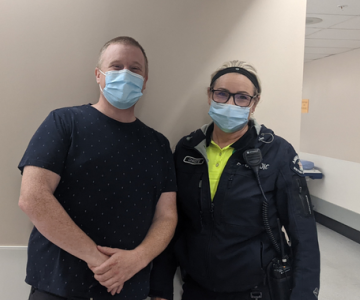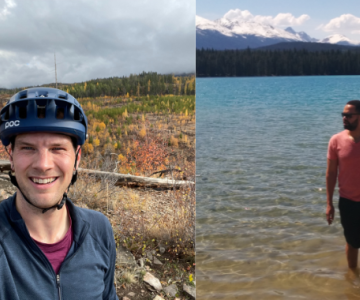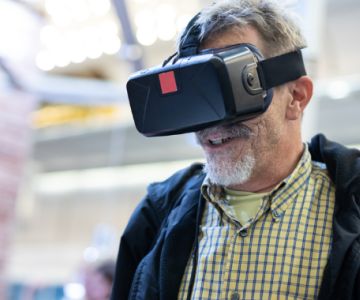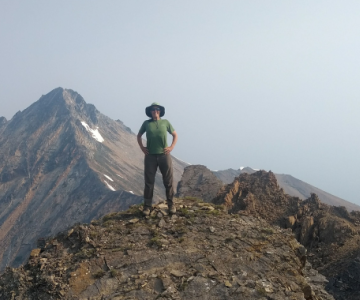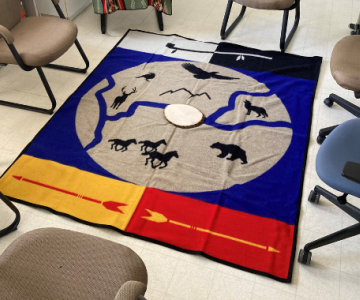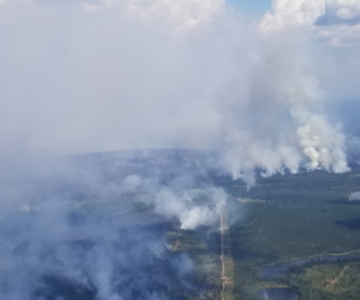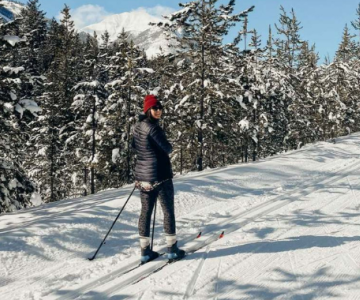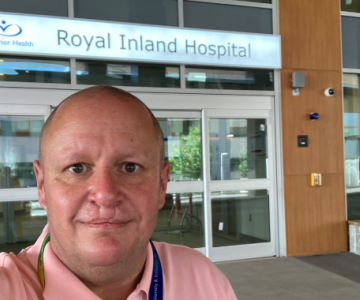Breadcrumb
Explore Stories
Health & Wellness
Kamloops social worker Rikki Barden with paramedic Christi Arnason
As the toxic drug crisis rages on, Interior Health’s mental health and substance use (MHSU) teams and B.C.’s paramedics are working together to connect people at risk to important health-care services.
On June 1, 2022, BC Emergency Health Services (BCEHS) introduced the new Assess, See, Treat and Refer (ASTaR) Pathway to serve people who use drugs throughout the province. With consent, paramedics connect people who have experienced a drug poisoning event but do not wish to go to hospital with outreach services within their geographical region.
“These outreach services include but are not limited to treatment, safe supplies, housing, peer support, and more. This pathway is one of many strategies BCEHS is putting in place for paramedics to reduce harm in their communities,” says Jennifer Bolster, a paramedic practice leader for BCEHS.
Those who agree are contacted at a later date by Interior Health MHSU, and offered appropriate services based on their personal situation and preferences.
The project opens up the communication between first responders and MHSU services, and provides new opportunities to provide people with supports they need.
“Not everyone who experiences a drug poisoning event wants to or even needs to come to the hospital,” says Amanda Lavigne, an IH clinical nurse specialist. “There are many reasons why someone may decline transport to hospital after an overdose – fear of someone they love finding out, the feeling of shame and being stigmatized in our health-care settings. But we then need to provide them with options for follow up and care in their community.
“You don’t need to be an MHSU client to accept support after toxic drug poisoning. It’s about offering people what they may need in their community after a traumatic event.”
Rikki Barden is a social worker at Royal Inland Hospital. He says the opportunity for people to be connected to supports through the new process can be life changing.
“You’ve got someone coming from a non-judgmental place to offer support to folks who may have never been attached to services, who have never reached out, and who may be hiding their addiction. Unlike someone who comes into the emergency department and then just wants to get out as quickly as possible, we can contact them after the fact on their own terms, and many people are really thankful for the opportunity to tell their story and be offered support.”
There is an emphasis on protecting people’s privacy and being person-centred.
“It’s so important that people get an opportunity to get connect to service, especially in the midst of this terrible toxic drug crisis,” Rikki says.
Learn more about Interior Health’s response to the toxic drug crisis
Health & Wellness
Did you know that the main cause of death for people under 45 in Canada is traumatic injury, and of the 750,000 injuries in British Columbia each year, 90 per cent are predictable and preventable?
The overall impact of traumatic injury is staggering. Of the 750,000 British Columbians injured each year, about 1,500 die, 9,000 suffer permanent disability, 30,000 are hospitalized and an estimated 70,000 potential years of life are lost.
The three leading causes of preventable traumatic injury in B.C. are:
Motor vehicle crashes
Falls amongst seniors
Drowning
Thinking ahead and having a plan can help prevent injuries. Here are some tips for creating a plan of your own.
Community & Culture
Dr. Matthew White (left) and Dr. Brenden van der Westhuizen (right)
About 20 per cent of all unscheduled emergency department visits in Interior Health are the result of an injury, or trauma. Contrary to popular belief, most injuries are not accidents – the majority of injuries are actually predictable and preventable. It’s the simple things we can do that count – taking a pause before acting, not using the phone while driving, putting on a helmet or wearing a life jacket.
We urge everyone across Interior Health to consider how you can help prevent injuries for yourself and those around you.
Meet two of our trauma physicians here at Interior Health.
Research & Innovation
Cindy is 86, grew up in Kelowna, and over the years has enjoyed all kinds of outdoor activities like mountain climbing, water sports, and horseback riding. The many things that still bring her comfort and joy are children, music, gardens and, most of all, animals.
Cindy lives in a long-term care facility and, like many, faced the challenges of social isolation during the COVID-19 pandemic.
To combat this, the seniors care team at Interior Health has introduced a new tool that can be personalized in a meaningful way for older adults like Cindy – virtual reality. By wearing virtual reality goggles, seniors in our long-term care homes can view familiar and joyful content, which can be beneficial to their physical, mental and emotional health. It also helps health-care teams as they work to match care needs in a person-centred way.
Cindy now has the opportunity to immerse herself virtually in activities that she was previously accustomed to. Because she loves animals, the staff provides content for her that feed that love, in this case a herd of horses with some roaming toward her, close enough to feed.
Cindy interacts with a virtual horse
The familiarity of the virtual reality content is stimulating and invites Cindy to engage with what she’s viewing by physically reaching out as if she’s feeding one of the horses some hay. Her body language transforms in a positive and dynamic way as she does this, as she’s stimulated physically, mentally and emotionally.
“Our minds are complex and can be stimulated by such positive and meaningful interactions,” says Joanna Harrison, IH executive director of Seniors Specialized Care. “Technology will permeate our health system in ways we have never experienced before. This is one example of embracing the era of digital health.”
Having the technology is one thing. Measuring if it has a positive impact on seniors’ quality of life and overall health is another. So, caregivers will be watching those who use virtual reality for positive signs in their emotional well-being and behaviour. These might include increased eye contact, more appetite and interest in food, participating in more recreational programs, a reduction in falls, and whether they proactively engage in self-care, such as requesting to get their hair done.
Could this be the future of one aspect of seniors’ care? So far, health-care teams have seen many benefits and also have witnessed acceptance of technological advances.
“More often than not we limit options for others based on our preconceived perceptions, like older adults can’t use technology, let alone virtual reality,” adds Joanna. “It’s intentional person-centred care, and a team approach is best.”
Community & Culture
Dr. Ilona Hale, on a ridge above 12 Mile Creek near Golden.
Name: Dr. Ilona Hale (she/her/hers)Job Title: Family Physician ResearcherYears of Service: 25Worksite: Kimberley Medical ClinicCommunity: KimberleyAncestral Territory: KtunaxaAdvice to live by: "Walk with the dreamers, the believers, the courageous, the cheerful, the planners, the doers, the successful people with their heads in the clouds and their feet on the ground. Let their spirit ignite a fire within you to leave this world better than you found it..." - Wilferd Peterson
Dr. Ilona Hale is no stranger to small-town life – she was born and raised in the mining town of Lively in Northern Ontario. Now, Ilona is a rural family physician in Kimberley, as well as a clinician researcher.
“I’ve always considered it an amazing privilege to practice medicine – to have the opportunity to be part of peoples' lives every day, and share tools to help them, even if it’s in a small way. When I see people getting better, it makes me want to keep going.”
Health & Wellness
A healing circle
Everyone deserves to be heard, and to feel safe and understood, but it’s clear from the In Plain Sight Report this doesn’t always happen for members of B.C.’s Aboriginal communities.
The Report, released November 2020, provides 24 recommendations for addressing Indigenous-specific racism within the B.C. health-care system. Among them was the development of a strategy that would improve patient complaint processes and address that racism, which is both individual and systemic.
With this in mind, Interior Health saw a way to create a more culturally safe space for complaint resolution through its Patient Care Quality Office. That’s how Lucie Poisson and Natalie Daniels (pictured below) came to be new Aboriginal Patient Care Quality and Safety Consultants. Patients and clients who self identify as Aboriginal now have an option to be directed to Natalie and Lucie for direct follow-up.
Aboriginal Patient Care Quality and Safety Consultants: Lucie Poisson (left) and Natalie Daniels
"Something that came out of the In Plain Sight Report is that respondents didn't feel comfortable bringing their concerns forward, and one of the barriers to bringing concerns forward to an office such as ours is that people didn't feel their concerns were going to be taken seriously," says Natalie.
Interior Voices podcast host Tracy Mooney recently met with Lucie, Natalie, and Shari McKeown, IH’s Director for Patient Safety, to discuss the new positions, and how they will contribute to better and more culturally safe recourse for people’s concerns.
Culturally safe recourse means that a patient or client has control of how the resolution process looks. They might choose to submit their concern in writing, have a phone call, or meet in person. Or, they might request a healing circle, have family or friends present with them, or another restorative approach.
"When a client is stepping forward with a concern or a story or an experience to share, that feedback is a gift for us and it leads to an opportunity to improve our care and services and make them safe for everybody's use," says Shari.
As Interior Health continues to work to improve health care for all, these new positions provide a culturally safe space for Aboriginal patients and clients to share.
"It's critical for us to hear from people about their experiences, worries and challenges in receiving care, or the omission of care, so that we can start to reconcile and take action," says Lucie.
Learn more:
Interior Voices podcast
Interior Health Patient Care Quality Office
In Plain Sight Report and Recommendations
Community & Culture
Mother Nature is glorious but fickle – we never know what she is going to hand us.
Folks in the Chilcotin are known to be resourceful and resilient, but our mettle was significantly tested during the massive firestorm of 2017, when three major complexes - the Plateau, Hanceville and West Chilcotin - burned 8,193 square kilometres. During the 2021 fire season, this area was under threat again as two significant wildfires at Big Stick Lake and Hotnarko Creek kept people living along the Highway 20 corridor on high alert.
The West Chilcotin Health Centre is small, so we have to handle whatever walks through the door. The building has a generator that starts automatically when the power cuts to allow continuous care. We are equipped with radios to connect with the local Search and Rescue, various community repeater systems, a satellite phone and spot device with text-based communication, and a GPS location tied to our manager’s email should we need further emergency assistance. We stock bottled water and dry food along with a small warehouse of medical supplies in case our highway is shut down.
Wildfire in the Cariboo Regional District
During the 2017 wildfires, one of our biggest challenges was acquiring medications for patients while the highway was closed. Our nurse practitioner Patrice Gordon and I gathered information about what medications our patients needed; some patients are so remote they required visitation by horseback from Patrice. We called the prescriptions into a Shopper’s Drug Mart in Nanaimo and they flew the medications into Bella Coola, where the medications were picked up by the RCMP and driven to the clinic or the local manor, where I was assisting after hours making food for fire crews.
The thing that I always take away from any disaster is how important it is to be fluid: for our patients and for ourselves. We must keep adjusting to whatever changes are thrown at us each day. No two events will ever be the same. Being prepared is so very important but being able to adapt within that emergency will always be the biggest asset.
About the author
Lee Anne Wright provides administrative support as a health unit aide in Alexis Creek and Tatla Lake.
Natural Disaster Champions series
In 2021, the B.C. Interior region experienced a natural disaster season like none other. Interior Health staff stepped up and came together to support each other, patients, friends, family and communities. We’re sharing the stories of staff members reflecting on how being prepared – at home and at work – can make all the difference when minutes matter.
View more stories in the series
Community & Culture
Michelle cross-country skiing at Dawn Mountain
Name: Michelle Plenderleith (she/her/hers)Job Title: Operating Room Booking / Nursing Unit Clerk Years of Service: 7Worksite: Golden & District HospitalCommunity: GoldenAncestral Territory: KtunaxaAdvice to live by: Let go of the small things.
Michelle’s favourite things about her job are three-fold:
Her coworkers, including nurses, physicians, and medical device reprocessing, administration and housekeeping staff
The patients she has the opportunity to see and talk to, and helping them navigate the health-care system
How fast paced her role is, and that it changes day to day so it’s never boring
Community & Culture
Peter Renn, project manager with Interior Health Capital Planning & Projects, in front of the new Phil & Jennie Gaglardi Tower at Royal Inland Hospital in Kamloops.
When Peter Renn woke up from the second coma he had slipped into in two weeks, he was at Royal Inland Hospital (RIH) in Kamloops, disoriented, scared and, according to his physician, near death.
A Kamloops resident, Peter had cirrhosis of the liver, brought on by a rare, inherited disease. Without a transplant, he was told he would likely die.
It was 2018 and the end of a 10-year journey of visits to various hospitals. By his count, nine times he was close to death. However, this time, everything had gotten worse. Twice he slipped into a coma. Awake in RIH, he was disoriented and fearful for his life - scared of losing his wife and his two young children.
“At that point, I was rock bottom,” he says. “I didn’t know whether I would live or die.”
After he was transferred from the ICU, his care was supported by other Interior Health teams. First, a student nurse calmed his fears with compassion and caring. Like an angel, she asked him what his three wishes would be if he could have them. He replied that he wanted the feeding tube gone, he needed water and he wanted to return to his family.
-
Load More
Showing 441 of 786
Sign up for email updates
Receive news, alerts, public service announcements and articles right to your inbox.


